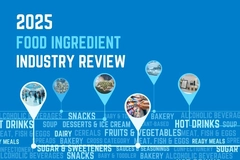
- Industry news
Industry news
- Category news
Category news
- Reports
- Key trends
- Multimedia
Multimedia
- Journal
- Events
- Suppliers
- Home
- Industry news
Industry news
- Category news
Category news
- Reports
- Key trends
- Multimedia
Multimedia
- Events
- Suppliers
Engineering mouthfeel: Food scientists identify what shapes the “perfect piece” of chocolate

25 Apr 2022 --- Unilever scientists and Dutch researchers have discovered the mouthfeel of food can be engineered just like the physical properties of many other non-edible materials. In the case of 3D-printed chocolate, the optimal textural experience depends largely on structure – specifically, when a number of cracks can be “programmed” into its surface.
This conclusion was derived from a study published in Soft Matter by researchers from Unilever alongside Dutch scientists at the University of Amsterdam and Delft University.
The design of edible metamaterials – materials that are not found in nature but that are carefully constructed in the lab – had not been studied before. The new research is hailed as a pathway to new methods of designing foods that are enjoyable to eat.

 Feeding chocolate through a 3D printer enables the formation of any desired shape.“Tunable fracture properties have tantalizing prospects for engineering applications where strong and tough structures are much needed,” the researchers stress. “However, little is known about how designed fracture could be used to enhance interactions between humans and materials.”
Feeding chocolate through a 3D printer enables the formation of any desired shape.“Tunable fracture properties have tantalizing prospects for engineering applications where strong and tough structures are much needed,” the researchers stress. “However, little is known about how designed fracture could be used to enhance interactions between humans and materials.”
“In particular, little is known about how to use tunable fracture to control mouthfeel and sensory experience upon biting,” they specify. “Controlling sensory experience is an important topic for the design of food products such as soups, yogurts, crackers, cookies and insects, as well as emulsions and protein-based food products.”
“Although the role of mechanical contrast is generally recognized to influence mouthfeel and the use of 3D printing is emerging as a promising avenue to shape the texture of food products, the use of mechanical metamaterials for tunable mouthfeel has not been explored.”
A delicate challenge
Both professional and amateur bakers are aware that chocolate is not the easiest food material to work with. Simply heating it up and cooling it down can turn soft chocolate into much more brittle tempered chocolate, or vice versa.
Therefore, the first challenge for the researchers was to get their building material under control. They did this by very carefully heating it up, adding some cold chocolate, cooling it down again, and then putting it in a 3D printer.
This allowed them to print essentially any shape of chocolate material they wanted, while guaranteeing that the base material always had the same properties.
The first shape of edible material that the scientists experimented with was an S-shaped chocolate with many twists. The goal was to test how this material would break and how that breaking would be experienced in the mouth.
Not surprisingly, the breaking properties depended strongly on the direction of “biting.”
When the chocolate was pressed from above, many different cracks occurred one after another, but when pressed in the direction perpendicular, usually only a single crack occurred.
This was tested mechanically, but also by feeding the chocolates to a panel of ten testers.
An S-shaped formation with many twists was investigated.The more cracks, the better
Most people enjoy the experience of food crackling down in their mouths – “the more cracks, the better,” as the researchers outline.
Having shown that such an experience can be designed, the researchers tested some different structures to identify a structure where the number of cracks can be “programmed” into the material.
It turned out that spiral-shaped chocolate metamaterials had “quite interesting and tunable” properties.
Not only does the number of windings directly control the number of cracks when the material is pressed mechanically; the test panel could also clearly distinguish between less and more cracks when eating the chocolates.
Moreover, sound recordings showed that the sound the chocolates make when being bitten reflects the number of cracks, adding to an enjoyable eating experience.
The perfect piece of chocolate
The researchers posit the question, “Is designing an enjoyable eating experience a matter of trial and error, or can edible materials actually be designed and fine-tuned before creating them?
The scientists found that with a well-chosen mathematical model, they can indeed optimize certain shapes of chocolates with respect to, for example, their resistance to break when bitten from certain directions.
According to Cargill research, seven in ten consumers say texture gives food and drinks a more interesting experience. This is especially true in confectionery, where a heightened sensory experience offers a greater feeling of indulgence.
The number of windings in a 3D printed chocolate determine the number of cracks it forms when eaten, which is a key factor in enjoyability.Over the last year, examples of inclusions that provide an appetizing texture in chocolate have expanded beyond nuts, cookies, nougatine, meringue and honeycomb. Crystallized flower petals and even crispy freeze-dried yogurt and honey have emerged in recipes.
Meanwhile, soft textures can also be obtained with chunks of pastries like brownie, or also candied or dried fruits. For a more gelatinous texture, chocolatiers have further explored the additions of jellybeans and marshmallows.
Texture continues to play a leading role in food formulation, extending beyond the realm of sweet. A previous soft matter physics study from Denmark and Germany explored how the food microstructure and rheology of foie gras and pâté affect its overall mouthfeel experience – shedding light on how fat distribution significantly affects outcomes.
By Benjamin Ferrer










